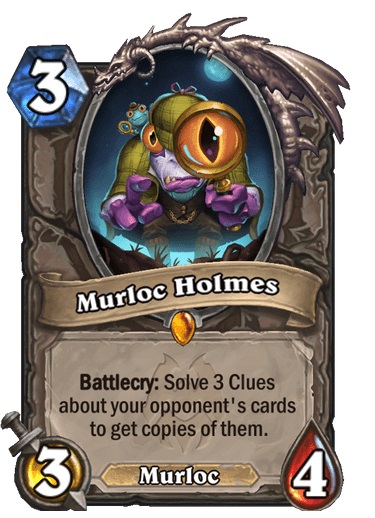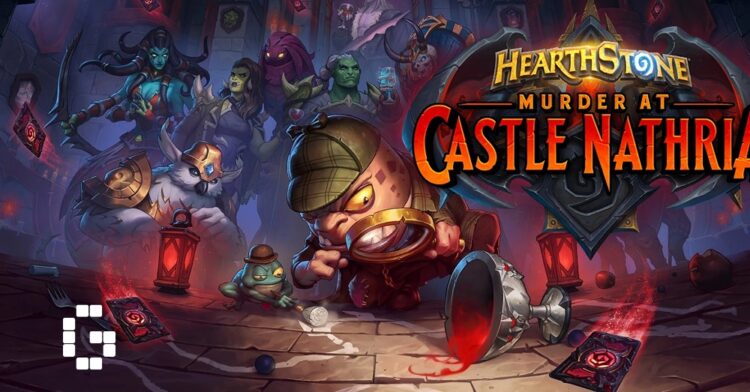Mystery settles over the tavern with the arrival of the Murder at Castle Nathria, Hearthstone‘s version of the Whodunnit Murder Mystery. That’s what Cora Georgiou, Game Designer and Set Design Lead for Castle Nathria, tells us in an email interview. Edward Goodwin, Associate Game Designer, also provided some answers, so do read on.
WELCOME TO THE CASTLE: Designing the expansion
Please tell us about the concept behind this expansion.
CORA GEORGIOU: I thought it would be fun to make a murder mystery expansion in Hearthstone, because even though the source material is dark and spooky, murder mysteries are often presented in a silly, comedic way. This transformation of dark and spooky into silly and whimsical is a very Hearthstone thing to do, and I think we nailed it in terms of art, voice lines, and flavour.
What was the idea behind the Location type card?
CORA GEORGIOU: We’ve been iterating on Locations for several years now. We playtested with Champion minions (Barrens) – later named Mercenaries – that had activatable abilities on board, which didn’t end up sticking. We tried again with Objectives (Voyage to the Sunken City), which also featured in Fractured in Alterac Valley.
From the start, we knew we were going to commit to making Locations as a new card type, and here they are over a year later! The idea was to be able to design these consistent tools for decks to use that players would be able to rely on having at the right time because they can’t be easily destroyed. We also wanted to be able to represent the different settings and environments in Hearthstone, because that’s something we’ve loved ever since Quests in Journey to Un’Goro.

How challenging was it to implement the “Infuse” keyword into the gameplay?
CORA GEORGIOU: Implementing “Infuse” wasn’t difficult, but deciding what it would do, was. For months, we tested a version where Infuse would transform mana into anima, with you spending anima for bonus effects. It was interesting but not very consistent, and didn’t feel any different from the normal mana system. The version of Infuse today is thematic, incentivizes minion combat that’s important to us this year, and is fun to play with!
Since this is the first expansion that ties directly into Shadowlands content, how was the experience working with the World of Warcraft team?
CORA GEORGIOU: We’re super privileged to have them as a resource! Being able to run the set by them occasionally to get their opinions on characters, mechanics, or lore is really helpful. It was actually the WoW teams idea to have Artificer Xy’mox as the Demon Hunter suspect, so thanks to them for that!

Following the reveal, fans seemed to really love the “Infuse” keyword. What’s the design philosophy behind it?
CORA GEORGIOU: One of our overarching goals for this year was to incentivize board-based gameplay and minion combat. “Infuse” is intended to encourage decks wanting to play wide boards of minions to benefit from powerful “Infuse” effects on cards like Sire Denathrius and Imp King Rafaam.
It’s a bonus that we get to capture our intended direction for gameplay and the story and theme of Revendreth and all of Shadowlands.
“Prince Renathal” and “Murloc Holmes” gives the impression of the developer team going more “extreme” and fun in designing cards. Is this a new approach or just something that aligned with the expansion’s theme?
CORA GEORGIOU: Hearthstone and us as game designers continue to grow and develop over time. We’ve established a wonderful baseline for card design and expansions that we feel comfortable breaking established rules assuming gameplay warrants it, taking appropriate risks if it means our players will have fun.
What was the most challenging part of this expansion?
CORA GEORGIOU: Finding the right execution for Locations and Infuse. We spent many months iterating on various designs for both mechanics with the final being very different from where we started. Ultimately, having ample time to iterate and playtest brought us to a final product with a good mix of theme, gameplay, and clarity that we’re very satisfied with.
Can you share any fun facts about how the team designed this new expansion?
CORA GEORGIOU: I’ll share one about everybody’s favorite Murloc Detective, Murloc Holmes!
Murloc Holmes would shuffle Clues into your deck. When playing a Clue, he would replace your hand with 10 suspect cards and give a hint to who the killer was that game. You would have to gather evidence and accuse a suspect of being a killer. If you were correct, you would get some awesome reward, though we didn’t actually figure out what that reward would be…

If you know how Murloc Holmes worked, he was really fun to play with. Otherwise, it was easily the most confusing card we have ever made in developing Hearthstone. Ultimately, it was too wacky and confusing, but it was fun.
SO, WHODUNNIT?: Gameplay Talk
How will Locations affect gameplay and strategy?
CORA GEORGIOU: They’re designed to be consistent tools players can depend on having at the right time because they’re difficult to destroy. We want players to commit to having some mana early on to play it since they’ll know it will be ready and waiting for when they can use it. We also want them to be careful on using their active abilities since they’d go on cooldown.
We think there’s tons of room to grow to develop Locations in the years to come, so we’re excited to see what they’d look like in the future.
“Prince Renathal”‘s 40 HP and 40 cards in a deck can disable some Archetype cards. What is the plan to resolve the possible problem of him having a huge impact on the game?
EDWARD GOODWIN: His effect on the live game is intended! While we didn’t want every deck to get better by including Renathal, we wanted to give players a chance to opt in to longer-lasting, slower games, as the option for players to play Hearthstone the way they want to. We’ll continue to monitor how Prince Renathal decks perform relative to the rest of the decks in our constructed formats, but we’re currently happy with how players are using him.

“Infuse” comes with minions, but in terms of spell features, there seems to be no difference with “Upgradable”. What are the differences between these keywords?
CORA GEORGIOU: “Infuse” essentially translates to “Upgrades in hand after X friendly minions die.” It’s a version of upgrading with a specific set of conditions done in a thematic way. The idea of upgrading cards over time has been in Hearthstone for years now in many different forms (Spellstones, Galakrond, Corrupt, etc), but they all feel different and unique to their own expansions.
Some players are concerned about Evolve Shaman becoming the main archetype for Shaman again. What can you tell about the Shaman’s design philosophy?
CORA GEORGIOU: Like with any class, we’re looking to provide new and interesting decks to utilize Shaman from expansion to expansion: new archetypes, or revisiting old ones. Evolve Shaman is a contentious deck historically, so we knew we needed to be careful to make it strong, but not too strong. I think that because the overall meta around Evolve Shaman is very different from previous iterations, we managed to land in a good space.
That said, it’s not fun when a single archetype crowds out others, so we’re keeping a watchful eye on Baroness Vashj and her Muck Pools.
CASE CLOSED?
Are Location cards launching only in this expansion, or should we be anticipating more Location cards to be included in upcoming expansions as well?
EDWARD GOODWIN: We’ll be making more in future expansions. Locations are where all of the story takes place and tell an awesome part of the story of expansions that was hard to capture in other card types. Locations allow us to include these iconic landmarks and structures from all over the Warcraft universe while still being tons of fun to play with.
Players seem to be having fun guessing who murdered Sire Denathrius. Do you have any clues you can share with us?
CORA GEORGIOU: I will just say that a lot of great mystery stories have surprising endings. We thought it could be fun to have multiple endings, but ultimately, we decided just one would suffice. I think some may see it coming, while others yet will be surprised.

What do you have to say to returning players who may check out this really fun Murder at Castle Nathria expansion?
CORA GEORGIOU: It goes for any player who plays this game: I hope you enjoy your time in the tavern! At the end of the day, we’re making a game that is supposed to serve our players, and it’s supposed to be fun.
Returning to a live service game after time away can be really daunting, so we hope the free decks we’ve started giving away can make that process easier. We have lots of game modes for people looking to experience Hearthstone, and I hope that one – or many! – click with you.
Murder at Castle Nathria is, simply put, really one of the most flavourful expansions in Hearthstone yet. As Cora puts it, the team have tried to include many elements of the classic murder mystery and apply them to the equally flavourful cast within Shadowlands.
Thanks to both Cora Georgiou and Edward Goodwin for their time answering the questions, and we’ll see you next mini set!










![[EXCLUSIVE] Inside Japan’s Indie Game Revolution – An Interview with BitSummit Organizer Masahiko Murakami](https://cdn.gamerbraves.com/2025/05/BitSummit-Orgainzer_Interview_FI-360x180.jpg)
![[EXCLUSIVE] The Art of Adaptation: Developer Interview Details the OVERLORD Mobile RPG Lord of Nazarick](https://cdn.gamerbraves.com/2025/05/Lord-of-Nazarick_Interview_FI-360x180.jpg)
![[EXCLUSIVE] Taking Gundam in Bold New Directions – Interview with GQuuuuuuX Director Kazuya Tsurumaki](https://cdn.gamerbraves.com/2025/04/Kazuya-Tsurumaki_Interview_FI-1-360x180.jpg)


![[SEA Exclusive] From Shadows to Shipwrecks – Jennifer English Talks About Bringing Emotional Depth to Clair Obscur: Expedition 33](https://cdn.gamerbraves.com/2025/04/Clair-Obscur-Jennifer-English_Interview_FI-360x180.jpg)

![[EXCLUSIVE] Do the Game Interview – An Intimate Look at the Challenges of Game Development](https://cdn.gamerbraves.com/2025/04/Do-the-Game_Interview_FI-1-360x180.jpg)
![[EXCLUSIVE] Interview with the Minds Behind of Den of Wolves – 10 Chambers’ New Sci-Fi Heist FPS](https://cdn.gamerbraves.com/2025/04/Den-of-Wolves_Interview_FI-360x180.jpg)









![[GUIDE] SD Gundam G Generation Eternal Unit Tier List](https://cdn.gamerbraves.com/2025/04/SD-Gundam-G-Generation-Eternal-Tier-List_Review_FI-360x180.jpg)
![[GUIDE] Clair Obscur: Expedition 33 Tier List – From Gustave to Verso: Who Deserves Your Party Slot?](https://cdn.gamerbraves.com/2025/04/Clari-Obscur-Expedition-33-Character-Tier-List_Guide_FI-360x180.jpg)